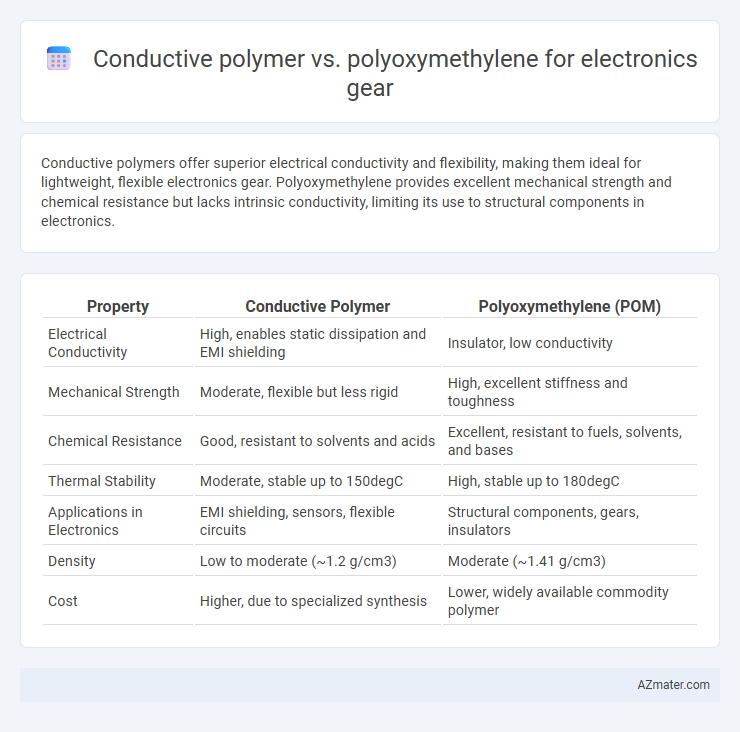Conductive polymers offer superior electrical conductivity and flexibility, making them ideal for lightweight, flexible electronics gear. Polyoxymethylene provides excellent mechanical strength and chemical resistance but lacks intrinsic conductivity, limiting its use to structural components in electronics.
Table of Comparison
| Property | Conductive Polymer | Polyoxymethylene (POM) |
|---|---|---|
| Electrical Conductivity | High, enables static dissipation and EMI shielding | Insulator, low conductivity |
| Mechanical Strength | Moderate, flexible but less rigid | High, excellent stiffness and toughness |
| Chemical Resistance | Good, resistant to solvents and acids | Excellent, resistant to fuels, solvents, and bases |
| Thermal Stability | Moderate, stable up to 150degC | High, stable up to 180degC |
| Applications in Electronics | EMI shielding, sensors, flexible circuits | Structural components, gears, insulators |
| Density | Low to moderate (~1.2 g/cm3) | Moderate (~1.41 g/cm3) |
| Cost | Higher, due to specialized synthesis | Lower, widely available commodity polymer |
Introduction to Conductive Polymer and Polyoxymethylene
Conductive polymers are organic polymers that conduct electricity and are widely used in flexible electronics, sensors, and wearable devices due to their unique combination of electrical conductivity and mechanical flexibility. Polyoxymethylene (POM), also known as acetal, is a highly crystalline thermoplastic used in electronic gear for precision parts requiring high stiffness, low friction, and excellent dimensional stability. While conductive polymers introduce electrical functionality, polyoxymethylene provides structural integrity and durability, making each material suited for specific roles within electronic equipment.
Material Properties Overview
Conductive polymers offer outstanding electrical conductivity, flexibility, and lightweight characteristics, making them ideal for wearable electronics and flexible circuits. Polyoxymethylene (POM) provides superior mechanical strength, dimensional stability, and excellent chemical resistance, essential for high-precision electronic gears and connectors. The choice between conductive polymer and POM depends on balancing electrical performance with structural durability requirements in electronic components.
Electrical Conductivity Comparison
Conductive polymers exhibit electrical conductivity ranging from 10^-5 to 10^3 S/cm, making them suitable for flexible electronics and anti-static components. Polyoxymethylene (POM), a traditional engineering plastic, has negligible electrical conductivity, typically below 10^-14 S/cm, resulting in excellent insulation properties. The significant conductivity difference positions conductive polymers as superior for applications requiring charge transport, while POM excels as an insulating structural material in electronic gear.
Mechanical Strength and Durability
Conductive polymers offer moderate mechanical strength but excel in electrical conductivity, making them suitable for flexible electronics components where durability under bending stress is critical. Polyoxymethylene (POM), also known as acetal, features high tensile strength and excellent wear resistance, providing superior mechanical durability for electronic gear subject to repetitive mechanical loads. In applications demanding robust structural integrity and long-term durability, POM outperforms conductive polymers, whereas conductive polymers are preferred in lightweight, flexible electronic assemblies requiring moderate mechanical strength.
Thermal Stability and Performance
Conductive polymers offer moderate thermal stability with onset degradation temperatures around 200-300degC, providing sufficient performance for flexible and low-heat electronics applications. Polyoxymethylene (POM) exhibits higher thermal stability, with melting points near 175-178degC and excellent dimensional stability under thermal stress, making it suitable for precision electronic gear requiring consistent mechanical performance. The choice between conductive polymers and POM depends on balancing electrical conductivity requirements with thermal endurance and mechanical reliability in electronic components.
Chemical Resistance in Electronics Applications
Conductive polymers exhibit superior chemical resistance in electronics applications compared to Polyoxymethylene (POM), making them ideal for environments exposed to solvents, acids, and alkalis. Polyoxymethylene, while offering good mechanical strength and dimensional stability, tends to degrade when exposed to strong chemicals and prolonged moisture, limiting its use in harsh chemical environments. The enhanced chemical resistance of conductive polymers ensures longer durability and reliability of electronic components subjected to aggressive chemical exposure.
Ease of Processing and Manufacturing
Conductive polymers offer superior ease of processing in electronics gear due to their solution processability and compatibility with printing techniques, enabling cost-effective, flexible circuit fabrication. Polyoxymethylene (POM), while exhibiting excellent mechanical strength and dimensional stability, requires more complex machining and molding processes, limiting rapid prototyping options. The inherent conductivity of conductive polymers reduces the need for additional metallization steps, streamlining manufacturing workflows compared to POM components that are typically insulating and require extra conductive treatments.
Typical Applications in Electronics Gear
Conductive polymers are widely used in flexible electronics, wearable devices, and electromagnetic interference (EMI) shielding components due to their excellent electrical conductivity and mechanical flexibility. Polyoxymethylene (POM), also known as acetal resin, is favored for precision gears, connectors, and insulators in electronic devices because of its high dimensional stability, low friction, and good dielectric properties. While conductive polymers enable enhanced performance in sensors and printed circuit boards (PCBs), POM ensures durability and reliability in mechanical parts within electronic gear assemblies.
Cost and Availability Analysis
Conductive polymers offer moderate cost advantages due to lower raw material expenses and simpler processing techniques compared to Polyoxymethylene (POM), which is typically more expensive given its high-performance engineering plastic status. Availability of conductive polymers is generally higher in specialty markets focused on flexible electronics, whereas POM benefits from widespread global manufacturing and distribution owing to its extensive use in mechanical components. Cost-efficiency in conductive polymers makes them suitable for budget-sensitive electronics gear, while POM's availability and consistent quality ensure reliability in high-precision electronic applications.
Environmental Impact and Sustainability
Conductive polymers offer significant advantages in electronics gear due to their lightweight and flexibility but often involve complex chemical synthesis that can produce hazardous byproducts, impacting environmental sustainability. Polyoxymethylene (POM), commonly used for its high mechanical strength and durability, generally exhibits a lower toxicity profile and better recyclability, making it more favorable for sustainable electronics manufacturing. Evaluating lifecycle assessments reveals POM's potential for reduced environmental impact through efficient end-of-life recycling compared to the more energy-intensive disposal processes required for conductive polymers.

Infographic: Conductive polymer vs Polyoxymethylene for Electronics gear
 azmater.com
azmater.com